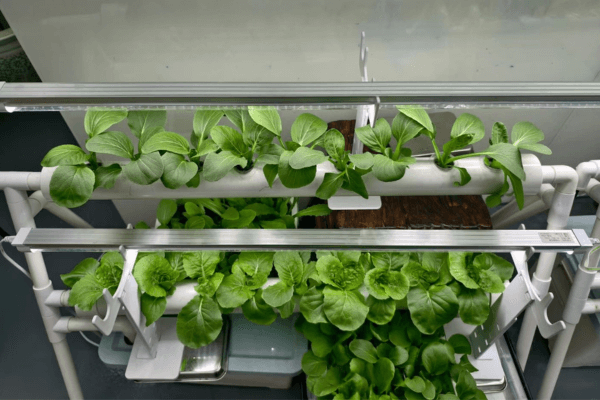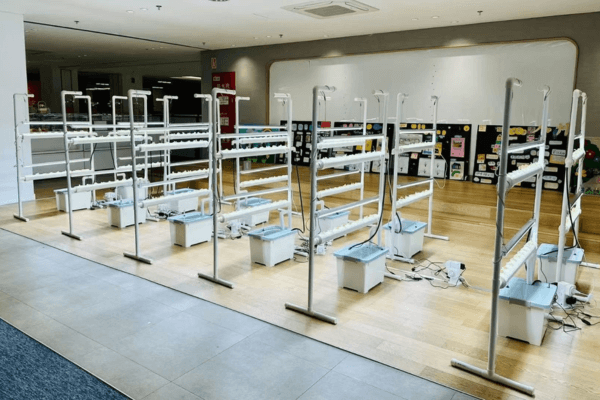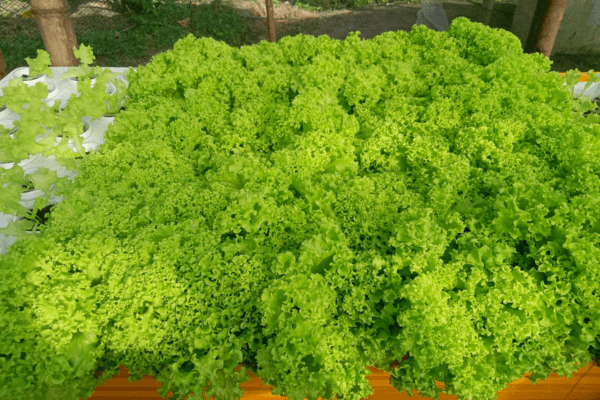Grow Leafy Greens in Hydroponics and enjoy fresh, crisp lettuce or fragrant basil straight from your kitchen, no matter the season. With hydroponic systems, cultivating leafy greens becomes not only possible but surprisingly simple. These fast-growing, nutrient-dense plants thrive in soilless setups, making them the perfect choice for beginners and seasoned growers alike.
Hydroponics provides a clean, efficient, and highly rewarding way to produce your own vegetables at home. Say goodbye to messy soil, garden pests, and unreliable weather conditions. Instead, take full control of your greens’ growth, from light and nutrients to harvest timing. Ready to bring your indoor garden to life? Let’s dive into how you can grow a continuous supply of leafy vegetables using this innovative method.
Why Choose Indoor Hydroponics for Leafy Greens? Benefits of Soilless Gardening
Choosing to grow your leafy greens hydroponically indoors comes with so many benefits:
Enjoy fresh greens all year round
You don’t have to wait for spring anymore. With an indoor hydroponic setup, your plants keep growing no matter the season, so you can enjoy crisp, healthy greens every single day of the year.
Cleaner and safer produce
Since hydroponics doesn’t use soil, there’s no dirt, fewer pests, and almost no risk of soil-borne diseases. You’ll use little to no pesticides, which means your food stays naturally clean and safe to eat.
Healthier eating made simple
When fresh greens are growing right beside you, eating healthy becomes effortless. It’s easy to pick what you need and add nutrient-rich vegetables to your meals whenever you like.
Perfect for small spaces
Hydroponic systems are designed to make the most of limited space. Even in a small apartment or kitchen corner, you can grow more than you might expect, especially with a vertical setup.
Faster growth and better harvests
With roots soaking directly in nutrient-rich water and receiving just the right amount of light, your plants grow faster and stronger than they would in soil. You’ll see the results in quicker harvests and more abundant greens.

Best Hydroponic Systems for Efficient Leafy Green Production
There are lots of hydroponic systems out there, but if you’re just starting and want to grow leafy greens indoors, Deep Water Culture is one of the easiest ways to go.
1. Deep Water Culture (DWC): Simple, reliable, and perfect for beginners
In this setup, your plants sit in small net pots, and their roots hang down into a container filled with nutrient-rich water. An air pump keeps the water full of oxygen, so the roots stay healthy and don’t rot.
What makes DWC great is how simple it is. It doesn’t take much to get started a dark plastic container, an air pump, an air stone, and a few net pots are all you really need. It’s affordable, easy to maintain, and your greens will grow fast and strong.
It works beautifully for plants like lettuce, spinach, kale, Swiss chard, basil, and mint all the leafy favorites that thrive in water and light.
2. Nutrient Film Technique (NFT): Scalable Hydroponic Solution for Greens
If you’ve already tried a basic setup and want to take things up a notch, the Nutrient Film Technique (NFT) is a great system to explore.
In an NFT setup, your plants grow in long channels, while a very thin layer of nutrient-rich water flows gently over their roots. The water moves in a loop, so it’s constantly refreshed and re-oxygenated as it cycles back into the reservoir.
What people love about NFT is how efficient it is. The plants get a steady supply of both nutrients and oxygen, which helps them grow quickly and stay strong. It’s a system that many commercial growers rely on, but you can easily build a smaller version for your home or balcony garden.
It works beautifully for lettuce, spinach, and herbs like basil or cilantro basically any fast-growing green that doesn’t need a lot of space or heavy fruiting.

3. Wick System: Simple, Low-Maintenance Hydroponics for Leafy Crops
If you’re looking for something super simple, the Wick System is as easy as it gets.
There are no pumps or complicated setups here. A piece of rope or felt strip acts as the wick, slowly drawing up nutrient-rich water from the reservoir to the plant’s roots. It’s quiet, gentle, and just works on its own.
What makes it great is how low-maintenance it is. You don’t need electricity (except maybe for your grow lights), and once it’s set up, there’s really not much to worry about. It’s perfect for small leafy greens, herbs, or even young seedlings when you just want something easy to manage.
Top Leafy Greens to Grow in Your Hydroponic Garden
Almost any leafy green will thrive in a hydroponic system, but some are particularly fast-growing and rewarding:
Almost any leafy green can do well in hydroponics, but some just grow faster, taste fresher, and make the whole experience more rewarding. Here are a few favorites that never disappoint:
Lettuce
Lettuce is a classic for a reason. It grows fast, stays crisp, and is usually ready to harvest in about three to four weeks. Varieties like Romaine, Butterhead, or Salanova do especially well in water.
Spinach
Spinach loves cool conditions and grows quickly too. You’ll get soft, tender leaves that are perfect for salads or light stir-fries.
Kale
Kale is tough, reliable, and keeps producing for weeks. Once you start harvesting, it just keeps growing back perfect for a steady supply of greens.
Basil
If you enjoy cooking, basil is a must. It thrives in hydroponic systems, smells amazing, and rewards you with plenty of fresh leaves for sauces, teas, or garnish.
Mint
Mint grows fast and spreads easily, giving you a never-ending supply of refreshing leaves for drinks or desserts. It’s almost impossible to mess up.
Swiss Chard
Swiss chard adds a pop of color to your garden and your plate. It grows well in water, and you can keep picking the outer leaves while the center keeps producing new ones.

Step-by-Step Guide to Growing Leafy Greens with Hydroponics
Ready to get your hands wet? Here’s how to give your leafy greens the best start in hydroponics
Step 1: Sprouting the Seeds
Start with a good medium like rockwool cubes, coco coir pellets, or peat plugs. Pop 2 or 3 seeds into each one, and keep them warm and consistently moist around 20 to 25°C works well. A clear dome or cover helps keep the humidity just right. If you’re patient, you’ll usually see little sprouts popping up in just a few days.
Step 2: Getting the Nutrient Solution Ready
Good water is the foundation. Clean, filtered water is ideal, but regular tap water often works fine as long as it’s not too hard. Mix in a nutrient solution made for leafy greens usually labeled as a “Grow” formula. Follow the instructions carefully, because too much fertilizer can stress the plants.
Step 3: Balancing pH and Nutrient Strength
Leafy greens like it slightly acidic, around pH 5.5 to 6.5. A simple pH kit or digital meter makes it easy to check and adjust with pH up or down solutions. For nutrient strength, aim for an EC of 1.2 to 1.8 or a TDS around 600 to 900 PPM. It may sound technical, but once you get the hang of it, it becomes second nature.
With just a little care at the beginning, you’ll soon have strong, healthy seedlings ready to grow into a flourishing indoor garden.

Step 4: Creating a Comfortable Home for Your Greens
This is where your leafy greens really start to thrive. Even in the middle of winter, you can make sure they stay happy and healthy.
Light is everything:Think of LED grow lights as your indoor sun. Leafy greens need plenty of light around 14 to 18 hours a day followed by a good stretch of darkness. A timer makes it easy to keep things consistent. Position your lights about 12 to 18 inches above the plants and adjust as they grow. They’ll soak up the light and flourish.
Temperature and humidity:Most leafy greens are happy around 18 to 24°C. Keep humidity comfortable, between 50 and 70 percent, and make sure the air is moving a little. Even a small fan helps strengthen stems, spreads CO2, and keeps things from getting too stagnant.
Step 5: Daily Care Without the Stress
Keeping your leafy greens happy doesn’t have to be complicated. The key is a little consistent attention each day. Check the water level and top it up with plain, pH-balanced water only the water evaporates, so you don’t need to add extra nutrients every time.
Every couple of days, take a quick look at the pH and nutrient strength. Small adjustments go a long way in keeping your plants healthy. About once a week or every two weeks, completely refresh the nutrient solution and give the reservoir a quick rinse. This keeps the water clean, prevents algae, and ensures your plants are getting everything they need to thrive.
And don’t forget to actually look at your plants. Watch for yellowing leaves, pests, or signs of stress from too much or too little light. Catching problems early makes a big difference. Whether you’re growing quick leafy greens or experimenting with more advanced crops like hydroponic tomatoes, a few minutes of daily care goes a long way.
Step 6: Harvesting Fresh Greens from Your Hydroponic Setup
The best part is watching your hard work pay off.
With most leafy greens, you can do a “cut-and-come-again” harvest. Snip the outer leaves and let the inner ones keep growing. This way, you’ll have fresh greens coming in continuously.
If you’re ready for a full harvest, just cut the plant at the base. Learning when and how to harvest lets you get the most out of your system, especially when using grow lights. Before you know it, your indoor garden will be producing healthy, tender greens week after week.

Common Issues When Growing Leafy Greens Hydroponically and How to Fix Them
Even experienced growers run into hiccups from time to time, but most problems are easy to fix once you know what to look for.
Yellowing Leaves
If your leaves start turning yellow, it usually means your plants aren’t getting the nutrients they need, the pH is off, or they’re not getting enough light. A quick check of your pH, EC, and light intensity can usually solve the problem.
Stretching or Leggy Plants
When plants stretch out and look leggy, it’s often a sign that they’re not getting enough light. Try lowering your grow lights or increasing their brightness so the leaves can reach their full potential.
Algae in the Reservoir
Algae grows when light reaches your nutrient solution. Make sure your reservoir is fully opaque and light-proof. Cleaning it during each nutrient change helps keep things under control.
Root Rot
Slimy or brown roots mean trouble. Low oxygen levels in the water or high temperatures are usually the culprits. Check that your air pump and air stone are working well, and consider cooling the reservoir if it gets too warm even adding frozen water bottles can help. If root rot appears, replace the water, trim damaged roots, and clean the system thoroughly.
Tips Browning or Crispy Leaves
This can happen if the EC is too high (nutrient burn) or if the lights are too close (light burn). Check your nutrient strength and adjust your lights to prevent further damage.
For plants with more specific needs, like strawberries, check out our guide on how to grow hydroponic strawberries for extra tips.
Frequently Asked Questions About Hydroponic Leafy Green Cultivation
Q1: My greens taste kind of bland. Am I doing something wrong?
A1: Not really. Some greens are naturally mild. If you want more flavor, make sure your plants get enough light especially red and a bit of far-red or UV. Also, check your nutrient balance (EC/TDS), a small tweak can boost taste.
Q2: Running grow lights 16 hours a day sounds expensive. Is it?
A2: Modern LED grow lights are very energy-efficient. For most home setups, the cost is low compared to buying store-bought greens. You can save more by dimming the lights or using staggered cycles.
Q3: Do I really need to change the water and nutrients so often?
A3: Yes, ideally every 1–2 weeks. Fresh solution keeps plants healthy and prevents algae or salt buildup. Once it’s routine, it’s quick and worth it for better harvests.
Q4: My plant roots look brown and slimy. What’s happening?
A4: That’s likely root rot. It usually happens when water lacks oxygen or is too warm. Check your air pump, cool the water if needed, trim damaged roots, and refresh the nutrient solution.
Q5: Can I reuse the old nutrient solution I drained out?
A5: It’s not recommended for hydroponics, especially for beginners. Nutrients are absorbed unevenly, so leftovers can be unbalanced. If you want, you can dilute it for outdoor plants, but using fresh solution indoors gives the best results.
Build Your Year-Round Indoor Garden with Hydroponic Leafy Greens
Growing leafy greens indoors with hydroponics is easier than you might think, and it’s surprisingly rewarding. Whether you’re watching the roots bubble in a simple DWC system or seeing the nutrient solution flow through an NFT setup, it’s exciting to watch your plants thrive and know exactly what’s going into your food.
The best part is having fresh, vibrant greens whenever you want them, no matter the season. A few simple steps, a little daily care, and you’ll have a steady supply of healthy, tasty leaves right in your kitchen. Why wait for spring? Your indoor hydroponic garden can start producing today.
Ready to Harvest Fresh, Home-Grown Hydroponic Greens?
Whether you’re starting with a small indoor setup or planning a full-scale hydroponic garden, growing leafy greens in hydroponics is easier and more rewarding than ever. This soilless method uses less water, saves space, and lets you harvest fresh, nutrient-packed greens all year round right from your own home.
No matter if you’re a gardening pro or just curious about sustainable growing, our step-by-step guide will help you master the essentials of hydroponic leafy greens. From choosing the right system to maintaining ideal conditions, we’ve got practical tips and expert advice to support you at every stage.
Ready to transform your home into a green oasis? Visit greenfuturehydro.com how to growing leafy greens in hydroponics to dive into the full guide. Explore our range of energy-efficient grow lights and hydroponic kits at greenfuturelight, and start growing your freshest greens today.
Already growing your own hydroponic greens? Share your success with us! Tag @Greenfuturehydro on Instagram or send us your story. Whether you need advice on nutrients, lighting, or system setup, our team is here to help you grow smarter and greener every day.


